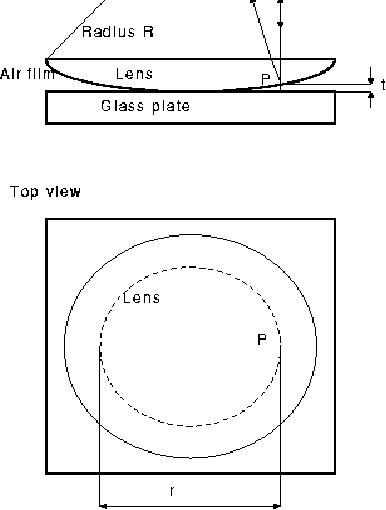For a lens with lower surface radius of curvature R resting on an optical flat

(that is, a glass plate whose upper surface is smooth on the scale of the wavelength of light) the thickness t of the gap at a distance r from the point of contact is given by
![]() (1)
(1)

or, as we will only observe interference near the point of contact where![]() (typical R is about 1m, typical t a few mm).
(typical R is about 1m, typical t a few mm).
![]() (2)
(2)
For Newton's rings with air in the gap, light reflected from the flat experiences a phase shift of![]() that from the bottom of the lens experiences no phase shift, so for constructive interference
that from the bottom of the lens experiences no phase shift, so for constructive interference
![]() (3)
(3)
This will occur all round the radius![]() giving a pattern of rings, so from (2) and (3)
giving a pattern of rings, so from (2) and (3)
![]() (4)
(4)
Note that one can fill the gap with a fluid (oil, water...) of refractive index![]() in which case it is the wavelength in that medium that must be used in this formula.
in which case it is the wavelength in that medium that must be used in this formula.
The centre of the pattern (if the surfaces are in good contact) will be dark.
For example, if![]() the first ring using (4) (with
the first ring using (4) (with![]() ) has a radius
) has a radius
![]()
and for the tenth (with p = 9 )![]()
